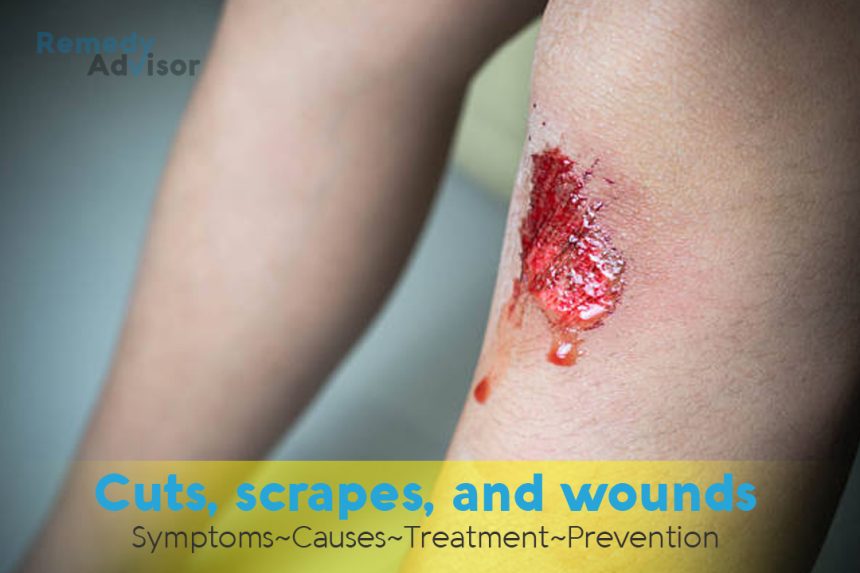What is it
At some time in your life, you are bound to suffer an accident in which you scrape, cut, or puncture your skin injuries in which the outer skin barrier has been penetrated. Because this leaves you prone to infection, the damage needs to be dealt with immediately.
Symptoms
- Symptoms range from narrow tears in the skin (cuts) to superficial abrasions (scrapes) to deep holes (punctures). Usually bleeding occurs, though some puncture wounds may bleed only slightly.
- If infection occurs, signs include redness, swelling, or discharge; fever; red streaks spreading from the wound site.
What causes it
A cut is typically caused by a sharp implement with an edge that may be smooth (a knife or a razor blade, for example) or jagged (a piece of broken glass). If the cut is deep, it will bleed profusely, and there may be damage to underlying muscle, tendons, and nerves. A scrape results from skin being rubbed against a rough surface like pavement. The outer skin layer may not be completely broken, but because small blood vessels are ruptured, the skin may ooze blood.
A puncture wound is caused by a nail, pin, or other sharp object with a penetrating point.
What if you do nothing
Most minor cuts and scrapes will heal on their own. However, skin is a barrier against germs and infections, so ignoring cuts and scrapes, no matter how minor, can leave you vulnerable to infection. Deep cuts or puncture wounds require medical attention.
Home remedies
Many remedies from hydrogen peroxide to Mercurochrome to antiseptic sprays and ointments have enjoyed popularity over the years. The truth is, most small wounds can be attended to without much doctoring and will heal in a week to 10 days.
First, stop the bleeding
If there’s any amount of it by applying pressure with a clean cloth or tissue. Since blood takes a while to clot, you may need to press down for as long as 10 minutes.
If blood soaks through the cloth or tissue, don’t remove it. Instead, apply another cloth on top of what you have in place and apply more pressure. If possible, elevate the wounded part above heart level to slow blood flow. (Exception: a puncture wound, from a nail or needle or similar long, sharp object, should be encouraged to bleed as part of the cleansing process.)
Second, avoid infection
This is the main concern with any small wound. You can best accomplish this by cleaning the wound and keeping it clean. Cleanse a scrape or cut by swabbing gently with a clean wet cloth or by holding the injured part under cold running water. Use a mild soap in the area, but try to keep it out of the wound per se because it can cause irritation. If there are dirt particles clinging to a scraped shin or elbow, remove them with tweezers (wash the tweezers first and dip the tips in alcohol).
If you can’t wash the wound, lick it
Licking a wound is a time-honored practice that may actually help disinfect it and promote healing, according to a small study in The Lancet. Researchers found that nitrites in saliva react with the skin to make nitric oxide, a chemical that can kill bacteria. Saliva also contains other substances that can help in healing.
Bandage it
If the wound is on the hand or finger and likely to get dirty, if the area needs protection from further injury, or if you’d just feel more comfortable not looking at the wound. a homemade or store-bought adhesive bandage is in order. Change the bandage frequently to keep the wound clean.
Don’t pick
It’s a good idea to keep small wounds dry and expose them to air as soon as possible. While scabs may not be desirable for large or surgical wounds, they protect against infection in small wounds. Don’t pick a scab off allow it to fall off after the skin has healed.
Skip the antiseptics
Antiseptic solutions rubbing alcohol, iodine, and hexylresorcinol-and hydrogen peroxide kill some microorganisms but they can also destroy skin cells. The Food and Drug Administration (FDA) permits them to be sold for cleaning small wounds, and if you feel you have to use something, make it alcohol. Iodine can actually bum your skin under a tight bandage. Hydrogen peroxide can damage the outer layers of the skin and thus retard healing. Such solutions as Mercurochrome and Merthiolate (once medicine cabinet staples) contain mercury, which is highly toxic, and are not judged safe or effective by the FDA.
Antibiotic ointments are unnecessary for small wounds and offer no benefits. If you want an ointment, use petroleum jelly.
Treatment for wounds
Help the bleeding
A puncture wound often doesn’t bleed freely, so bacteria, instead of washing away, may be sealed in. If such a wound is not bleeding enough, press gently around the wound to encourage bleeding.
Clean the wound
Examine the wound and remove any foreign objects from it. Clean the wound with soap and water and cover it with a sterile dressing.
A deep puncture wound on the hand may lead to an infection that is hard to combat; preventive antibiotic treatment may be advisable for such a wound. If the wound is deep or was made with a dirty object and you haven’t had a tetanus shot within 10 years, contact your doctor about tetanus immunization.







